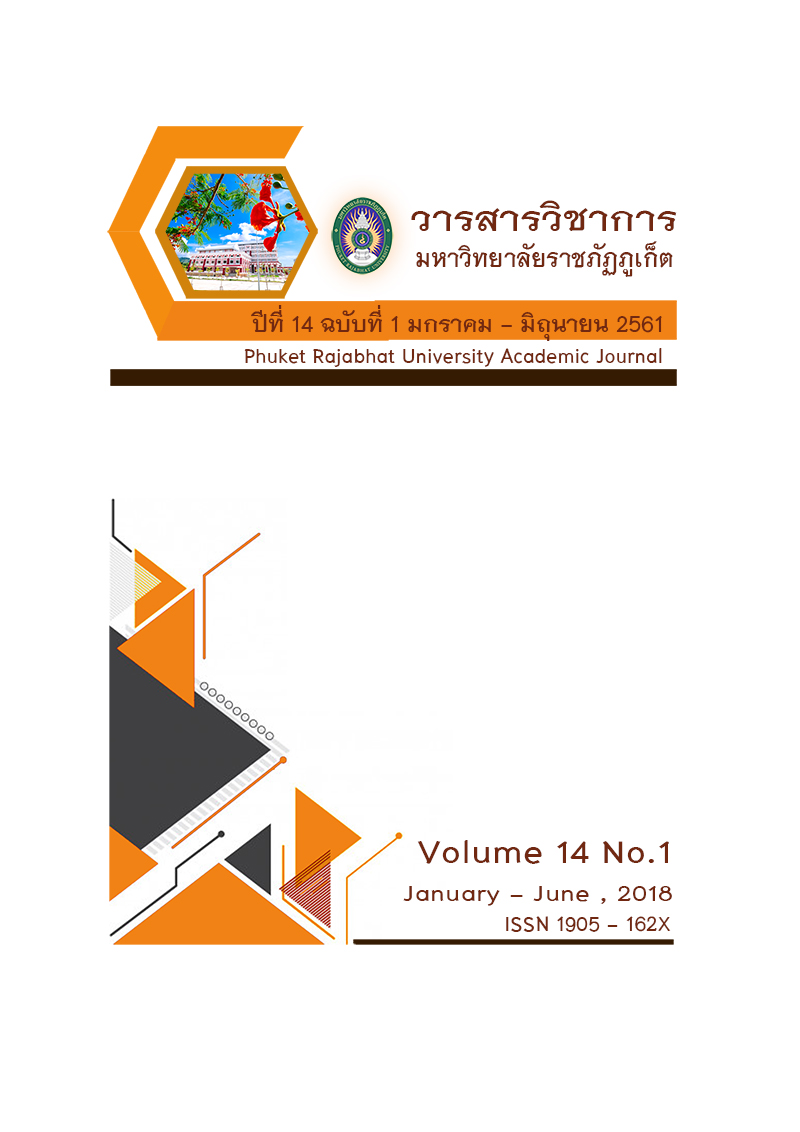คุณค่าตราสินค้าในมุมมองของผู้บริโภคสำหรับแหล่งท่องเที่ยว: บททบทวนวรรณกรรม กรอบแนวความคิด และแบบจำลองที่นำเสนอใหม่
Main Article Content
บทคัดย่อ
บทความนี้กล่าวถึงการนำแนวคิดคุณค่าตราสินค้าในมุมมองของผู้บริโภค มาปรับใช้ในบริบทของการท่องเที่ยว หรือที่เรียกว่า “คุณค่าตราสินค้าในมุมมองของผู้บริโภคสำหรับแหล่งท่องเที่ยว (Customer-based Brand Equity for Tourism Destination: CBBETD)” ซึ่งมีบทบาทสำคัญในการใช้เป็นเครื่องมือในการประเมินประสิทธิภาพการบริหารตราสินค้าที่เป็นแหล่งท่องเที่ยวขององค์กรที่เกี่ยวข้อง เพื่อตรวจสอบว่าการรับรู้ต่อแหล่งท่องเที่ยวในฐานะที่เป็นตราสินค้าในแง่มุมต่างๆ ของนักท่องเที่ยว สอดคล้องกับเอกลักษณ์ตราสินค้าที่เป็นแหล่งท่องเที่ยวที่นักการตลาดหรือผู้จัดการแหล่งท่องเที่ยวกำหนดขึ้นหรือไม่ และมีองค์ประกอบใดบ้างที่มีอิทธิพลหรือส่งผลให้เกิดเป็นมูลค่าเพิ่ม (Added Value) ของแหล่งท่องเที่ยว อันเนื่องมาจากชื่อของแหล่งท่องเที่ยว เมื่อเปรียบเทียบกับคู่แข่งขันที่เป็นแหล่งท่องเที่ยวประเภทเดียวกัน โดยเนื้อหาในบทความศึกษาค้นคว้าจากการวิเคราะห์เนื้อหาที่เป็นการทบทวนแนวคิด ทฤษฎีและงานวิจัยเชิงประจักษ์ที่เกี่ยวข้องกับคุณค่าตราสินค้าในมุมมองของผู้บริโภคสำหรับแหล่งท่องเที่ยวซึ่งเนื้อหาในบทความนี้สี่ส่วนหลักคือ 1) ที่มาและวิวัฒนาการของการศึกษาด้าน CBBETD 2) จุดเน้น ความเหมือน และความต่างของการศึกษาเกี่ยวกับ CBBETD โดยนักวิชาการกลุ่มต่างๆ และ 3) รายละเอียดของข้อเสนอแบบจำลอง CBBETD ที่ผู้เขียนนำเสนอขึ้นใหม่ ซึ่งมีทั้งหมดหกองค์ประกอบหลัก โดยองค์ประกอบที่ผู้เขียนนำเสนอขึ้นใหม่ คือ ความเชื่อถือได้ของตราสินค้าแหล่งท่องเที่ยว และการรับรู้ความคุ้มค่าตราสินค้าแหล่งท่องเที่ยว ซึ่งในองค์ประกอบหลังนี้ได้เพิ่มเติมมิติการประเมินให้มีความครอบคลุมมากยิ่งขึ้น
Article Details
เนื้อหาและข้อมูลในบทความที่ลงตีพิมพ์ในวารสารวิชาการมหาวิทยาลัยราชภัฏภูเก็ต ถือเป็นข้อคิดเห็นและความรับผิดชอบของผู้เขียนบทความโดยตรง ซึ่งกองบรรณาธิการวารสารฯ ไม่จำเป็นต้องเห็นด้วยหรือร่วมรับผิดชอบใด ๆ
บทความ ข้อมูล เนื้อหา รูปภาพ ฯลฯ ที่ได้รับการตีพิมพ์ในวารสารวิชาการมหาวิทยาลัยราชภัฏภูเก็ต ถือเป็นลิขสิทธิ์ของวารสารวิชาการมหาวิทยาลัยราชภัฏภูเก็ต หากบุคคลหรือหน่วยงานใดต้องการนำทั้งหมดหรือส่วนหนึ่งส่วนใดไปเผยแพร่ต่อหรือเพื่อกระทำการใด ๆ จะต้องได้รับอนุญาตเป็นลายลักษณ์อักษรจากวารสารวิชาการมหาวิทยาลัยราชภัฏภูเก็ตก่อนเท่านั้น
เอกสารอ้างอิง
Aaker, D. A. (1996). Building strong brands. New York: Free Press.
Balakrishnan, M. S. (2009), Strategic branding of destinations. European Journal of Marketing, 43(5/6), 611-629.
Blain, C., Levy, S. E., & Ritchie, J., R., B. (2005). Destination branding: Insights and practices from destination management organizations. Journal of Travel Research, 43(May), 328-338.
Boo, S., Busser, J., & Baloglu, S. (2009). A model of customer-based brand equity and its application to multiple destinations. Tourism Management, 30, 219-231.
Dosen, D. O., Vranesevic, T., & Prebezac, D. (1998). The importance of branding in the development of marketing strategy of Croatia as tourist destination. Acta Turistica, 10, 93-182.
Ellwood, I. (2009). Brand Strategy. In R. Clifton (Ed.), Brand and branding (2 ed., pp. 73-95). NY: Bloomberg Press.
Gartner, W. C., & Ruzzier, K. M. (2011). Tourism destination brand equity dimensions: Renewal versus repeat market. Journal of Travel Research, 50(5), 471-481.
Hankinson, G. (2005), Destination brand images: A business tourism perspective. The Journal of Services Marketing, 19(1), 24-32.
Hsu, H. C. C., Oh, H., & Assaf, G. (2012). A customer-based equity model for upscale hotels. Journal of Travel Research, 51(1), 81-93.
Im, H. H., Kim, S. S., Elliot, S., & Han, H. (2012). Conceptualizing destination brand equity dimensions from a customer-based brand equity perspective. Journal of Travel & Tourism Marketing, 29(4), 385-403.
Jamal, A. S., Othman, N., & Muhammad, N. M. N. (2011). The moderating influence of psychographics in homestay tourism in Malaysia. Journal of Travel & Tourism Marketing, 28, 48-61.
Keller, K. L. (1993). Conceptualizing, measuring, and managing customer-based brand equity. Journal of Marketing, 57(1), 1–22.
Keller, K. L. (2003). Strategic brand management: Building, measuring, and managing brand equity (2nd ed.). Upper Saddle River, NJ: Prentice-Hall.
Konecnik, M. (2006). Croatian-based brand equity for Slovenia as a tourism destination. Economic and Business Review, 8(1), 83-108.
Konecnik, M., & Gartner, C. W. (2007). Customer-based brand equity for a destination. Annals of Tourism Research, 34(2), 400-421.
Konecnik, M., & Go, F. (2008), Tourism destination brand identity: The case of Slovenia. Brand Management, 15(3), 177-189.
Kotler, P. (2003). Marketing management: analysis, planning, implementation, and control (11th ed.). Englewood Cliffs, NJ: Prentice-Hall.
Lee, J., Lee, C., & Choi, Y. (2011). Examining the role of emotional and functional values in festival evaluation. Journal of Travel Research, 50(6), 685-696.
Low, G. S., & Lamb, C. W. (2000). The measurement and dimensionality of brand associations. Journal of Product and Brand Management, 9(6), 350–368.
McCartney, G., Butler, R., & Bennett, M. (2008), A strategic use of the communication mix in the destination image-formation process. Journal of Travel Research, 47(2), 183-196.
Parasuraman, A., Zeithaml, V. A., & Berry, L. L. (1994). Reassessment of expectations as a comparison standard in measuring service quality: Implications for further research. Journal of Marketing, 58(1), 111-124.
Pike, D. S., Bianchi, C., Kerr, G. F., & Patti, C. (2010). Customer-based brand equity for Australia as a long haul tourism destination in an emerging market. International Marketing Review, 27(4), 1-25.
Pike, S. (2007). Customer-based brand equity for destinations: Practical DMO performance measures. Journal of Travel & Tourism Marketing, 22(1), 51-61.
Pike, S. (2010). Destination branding case study: Tracking brand equity for an emerging destination between 2003 and 2007. Journal of Hospitality & Tourism Research, 34(1), 224-139.
Pritchard, A., & Morgan, N. J. (1998). Mood marketing--The new destination branding strategy: A case of Wales the brand. Journal of Vacation Marketing, 4, 215-229.
Sheth, J. N., Newman, B. I., & Gross, B. L. (1991). Why we buy what we buy: A theory of consumption values. Journal of Business Research, 22(2), 159-170.
Solomon, M. R. (1999). Consumer behavior: Buying, having and being (4th ed.). Upper Saddle River, NJ: Prentice-Hall.
Tasci, A. D. A., Gartner, W. C., & Cavusgil, S. T. (2007). Measurement of destination brand bias using a quasi-experimental design. Tourism Management, 28(6), 1529–1540.
Yoo, B., & Donthu, N. (2001). Developing and validating a multidimensional consumer-based brand equity scale. Journal of Business Research, 52(1), 1–14.
Yoo, B., Donthu, N., & Lee, S. (2000). An examination of selected marketing mix elements and equity. Journal of the Academy of Marketing Science, 28, 195-211.


